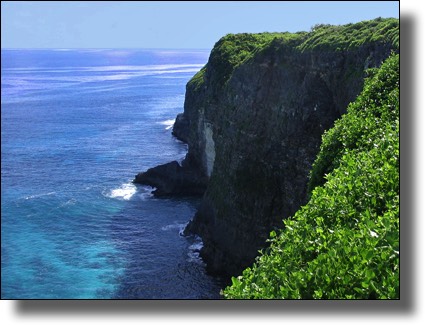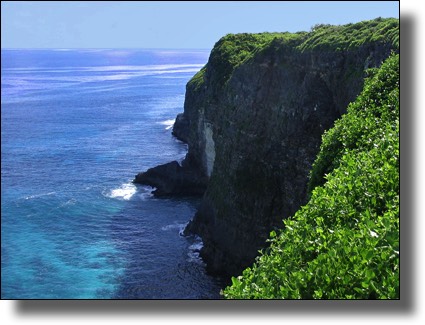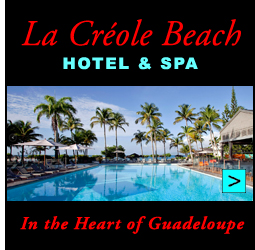Marie-Galante Tours, Sightseeing
Marie-Galante offers a variety of fascinating places to visit and tour, either on your own or with one of several companies offering mini-bus tours of the island.

The charming town of Grand-Bourg is the administrative and commercial center of Marie-Galante. The little museum there called Au Mouillage, retracing the genealogy of the different means of transportation on the island since 1900, is worth a visit.
Not far from Grand-Bourg, Château Murat and its windmill, built during the eighteenth century, are highlights for visitors to Marie-Galante. The facility houses an eco-museum featuring the history of sugar production, a medicinal garden and authentic slave quarters. About one mile north, the Mare au Punch awaits. It is said that during the French Revolution, slaves who were fighting for freedom poured all the sugar and the rum they could find into the pond and set it on fire to make the biggest bowl of punch ever prepared.
The distilleries of Marie-Galante are famed throughout the Caribbean. Some claim that sugar cane originated in New Guinea, others, that Alexander the Great brought it back from India. Nevertheless, Christopher Columbus imported it to the new world. The tropical climate of the Caribbean islands proved to be ideal for the culture of sugar cane.
Three distilleries operate in Marie-Galante:
On the way to Saint-Louis, the Distillerie Poisson can be found. It produces the Rhum du Père Labat, considered by some the best Caribbean white rum. In its small museum, viewing historical artifacts can be combined with pleasure in a rum-tasting session.
Distillerie Bielle, located near Grand-Bourg, and Rhumeries Agricoles de Bellevue, near Capesterre, also offer museums, tours and/or tastings. Distillerie Bielle also features a pottery workshop, which produces wonderful jugs and bottles. Cane syrup is produced in small factories in both Cappesterre and Grand-Bourg that are open to the public.
Proceeding north from Distillerie Poisson, the fishing village of Saint-Louis offers a pure Créole-style open market, and beyond, the peaceful and enchanting Vieux Fort River displays an incredibly rich environment of botanical and animal species and can be explored by boat and kayak. Ecological tours are available.
On the northern cliffs of Marie-Galante, a spectacular cove called the Gueule Grand Gouffre (Mouth of the Giant), opens onto the sea through a naturally sculptured gigantic arch. Please be careful by the edge - you don't want to be swallowed by the giant. Further along the coast, the grandeur of the magnificent cliffs of Caye Plate offers the visitor an unforgettable sight.
Inland, close to Bazaars Mill, the subterranean lake at Trou du Diable (Devil's Hole) is another acclaimed attraction. With professional guides, it can be visited with climbing ropes.
And finally, on the south-east coast, charming Capesterre, a traditional village of small white and red houses built around the church, is the starting point for several interesting hiking tours.
Marie-Galante is also known as the "Island of 100 Windmills". Only 72 of these moulins have actually survived through the centuries and they can be seen all around the island. Those of particular note include:
Roussel-Trianon Windmill, north of Grand-Bourg. This incredible property attracts visitors charmed by its cut stone buildings and well-preserved red brick stables. Bezard Windmill near Capesterre, operational until 1954, has been beautifully restored. And Ballet Windmill was built on the spot where Christopher Columbus landed on November 3, 1493.
Modern wind power is being harnessed in Petite Place, near Capesterre, where a wind farm now produces 30% of the island's electricity.
To this day, Marie-Galante continues to offer the unexpected sight of traditional oxcarts carrying sugar cane in from the fields, one of the few places remaining in which they are still used. Oxen participate in tug-of-war competitions that take place from June to February, and ox cart rides are available to visitors near Grand-Bourg and Cappesterre.
Not far from Grand-Bourg, Château Murat and its windmill, built during the eighteenth century, are highlights for visitors to Marie-Galante. The facility houses an eco-museum featuring the history of sugar production, a medicinal garden and authentic slave quarters. About one mile north, the Mare au Punch awaits. It is said that during the French Revolution, slaves who were fighting for freedom poured all the sugar and the rum they could find into the pond and set it on fire to make the biggest bowl of punch ever prepared.
The distilleries of Marie-Galante are famed throughout the Caribbean. Some claim that sugar cane originated in New Guinea, others, that Alexander the Great brought it back from India. Nevertheless, Christopher Columbus imported it to the new world. The tropical climate of the Caribbean islands proved to be ideal for the culture of sugar cane.
Three distilleries operate in Marie-Galante:
On the way to Saint-Louis, the Distillerie Poisson can be found. It produces the Rhum du Père Labat, considered by some the best Caribbean white rum. In its small museum, viewing historical artifacts can be combined with pleasure in a rum-tasting session.
Distillerie Bielle, located near Grand-Bourg, and Rhumeries Agricoles de Bellevue, near Capesterre, also offer museums, tours and/or tastings. Distillerie Bielle also features a pottery workshop, which produces wonderful jugs and bottles. Cane syrup is produced in small factories in both Cappesterre and Grand-Bourg that are open to the public.
Proceeding north from Distillerie Poisson, the fishing village of Saint-Louis offers a pure Créole-style open market, and beyond, the peaceful and enchanting Vieux Fort River displays an incredibly rich environment of botanical and animal species and can be explored by boat and kayak. Ecological tours are available.
On the northern cliffs of Marie-Galante, a spectacular cove called the Gueule Grand Gouffre (Mouth of the Giant), opens onto the sea through a naturally sculptured gigantic arch. Please be careful by the edge - you don't want to be swallowed by the giant. Further along the coast, the grandeur of the magnificent cliffs of Caye Plate offers the visitor an unforgettable sight.
Inland, close to Bazaars Mill, the subterranean lake at Trou du Diable (Devil's Hole) is another acclaimed attraction. With professional guides, it can be visited with climbing ropes.
And finally, on the south-east coast, charming Capesterre, a traditional village of small white and red houses built around the church, is the starting point for several interesting hiking tours.
Marie-Galante is also known as the "Island of 100 Windmills". Only 72 of these moulins have actually survived through the centuries and they can be seen all around the island. Those of particular note include:
Roussel-Trianon Windmill, north of Grand-Bourg. This incredible property attracts visitors charmed by its cut stone buildings and well-preserved red brick stables. Bezard Windmill near Capesterre, operational until 1954, has been beautifully restored. And Ballet Windmill was built on the spot where Christopher Columbus landed on November 3, 1493.
Modern wind power is being harnessed in Petite Place, near Capesterre, where a wind farm now produces 30% of the island's electricity.
To this day, Marie-Galante continues to offer the unexpected sight of traditional oxcarts carrying sugar cane in from the fields, one of the few places remaining in which they are still used. Oxen participate in tug-of-war competitions that take place from June to February, and ox cart rides are available to visitors near Grand-Bourg and Cappesterre.

The charming town of Grand-Bourg is the administrative and commercial center of Marie-Galante. The little museum there called Au Mouillage, retracing the genealogy of the different means of transportation on the island since 1900, is worth a visit.
Not far from Grand-Bourg, Château Murat and its windmill, built during the eighteenth century, are highlights for visitors to Marie-Galante. The facility houses an eco-museum featuring the history of sugar production, a medicinal garden and authentic slave quarters. About one mile north, the Mare au Punch awaits. It is said that during the French Revolution, slaves who were fighting for freedom poured all the sugar and the rum they could find into the pond and set it on fire to make the biggest bowl of punch ever prepared.
The distilleries of Marie-Galante are famed throughout the Caribbean. Some claim that sugar cane originated in New Guinea, others, that Alexander the Great brought it back from India. Nevertheless, Christopher Columbus imported it to the new world. The tropical climate of the Caribbean islands proved to be ideal for the culture of sugar cane.
Three distilleries operate in Marie-Galante:
On the way to Saint-Louis, the Distillerie Poisson can be found. It produces the Rhum du Père Labat, considered by some the best Caribbean white rum. In its small museum, viewing historical artifacts can be combined with pleasure in a rum-tasting session.
Distillerie Bielle, located near Grand-Bourg, and Rhumeries Agricoles de Bellevue, near Capesterre, also offer museums, tours and/or tastings. Distillerie Bielle also features a pottery workshop, which produces wonderful jugs and bottles. Cane syrup is produced in small factories in both Cappesterre and Grand-Bourg that are open to the public.
Proceeding north from Distillerie Poisson, the fishing village of Saint-Louis offers a pure Créole-style open market, and beyond, the peaceful and enchanting Vieux Fort River displays an incredibly rich environment of botanical and animal species and can be explored by boat and kayak. Ecological tours are available.
On the northern cliffs of Marie-Galante, a spectacular cove called the Gueule Grand Gouffre (Mouth of the Giant), opens onto the sea through a naturally sculptured gigantic arch. Please be careful by the edge - you don't want to be swallowed by the giant. Further along the coast, the grandeur of the magnificent cliffs of Caye Plate offers the visitor an unforgettable sight.
Inland, close to Bazaars Mill, the subterranean lake at Trou du Diable (Devil's Hole) is another acclaimed attraction. With professional guides, it can be visited with climbing ropes.
And finally, on the south-east coast, charming Capesterre, a traditional village of small white and red houses built around the church, is the starting point for several interesting hiking tours.
Marie-Galante is also known as the "Island of 100 Windmills". Only 72 of these moulins have actually survived through the centuries and they can be seen all around the island. Those of particular note include:
Roussel-Trianon Windmill, north of Grand-Bourg. This incredible property attracts visitors charmed by its cut stone buildings and well-preserved red brick stables. Bezard Windmill near Capesterre, operational until 1954, has been beautifully restored. And Ballet Windmill was built on the spot where Christopher Columbus landed on November 3, 1493.
Modern wind power is being harnessed in Petite Place, near Capesterre, where a wind farm now produces 30% of the island's electricity.
To this day, Marie-Galante continues to offer the unexpected sight of traditional oxcarts carrying sugar cane in from the fields, one of the few places remaining in which they are still used. Oxen participate in tug-of-war competitions that take place from June to February, and ox cart rides are available to visitors near Grand-Bourg and Cappesterre.
________________________________________
French Caribbean International has been the premier guide to the French West Indies since 1994. We provide a wealth of helpful travel information for visitors to the Caribbean islands of St. Barthélemy (St. Barts, St. Barth, St. Barths), St. Martin / St. Maarten, Martinique, Guadeloupe, Les Saintes and Marie-Galante.







